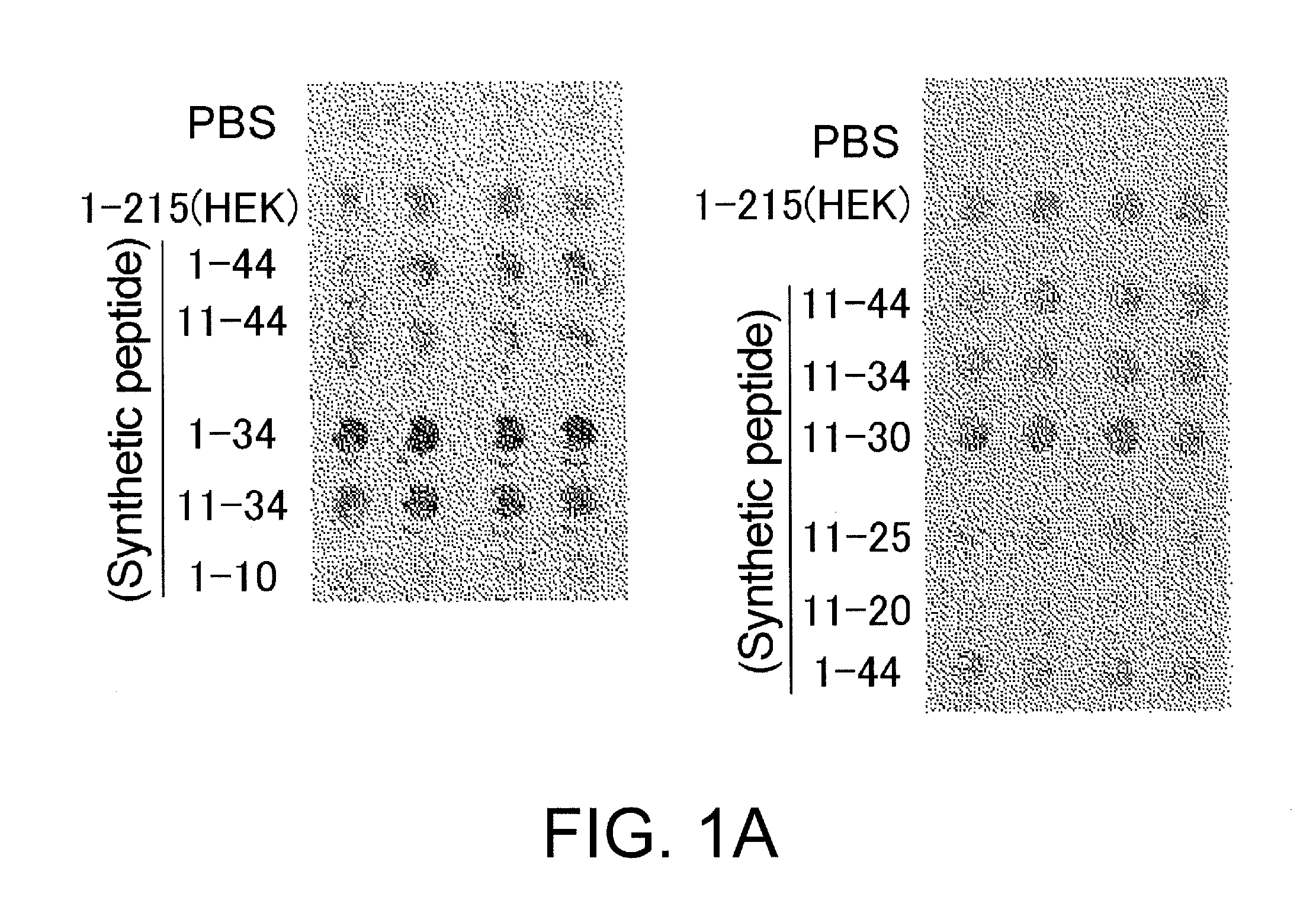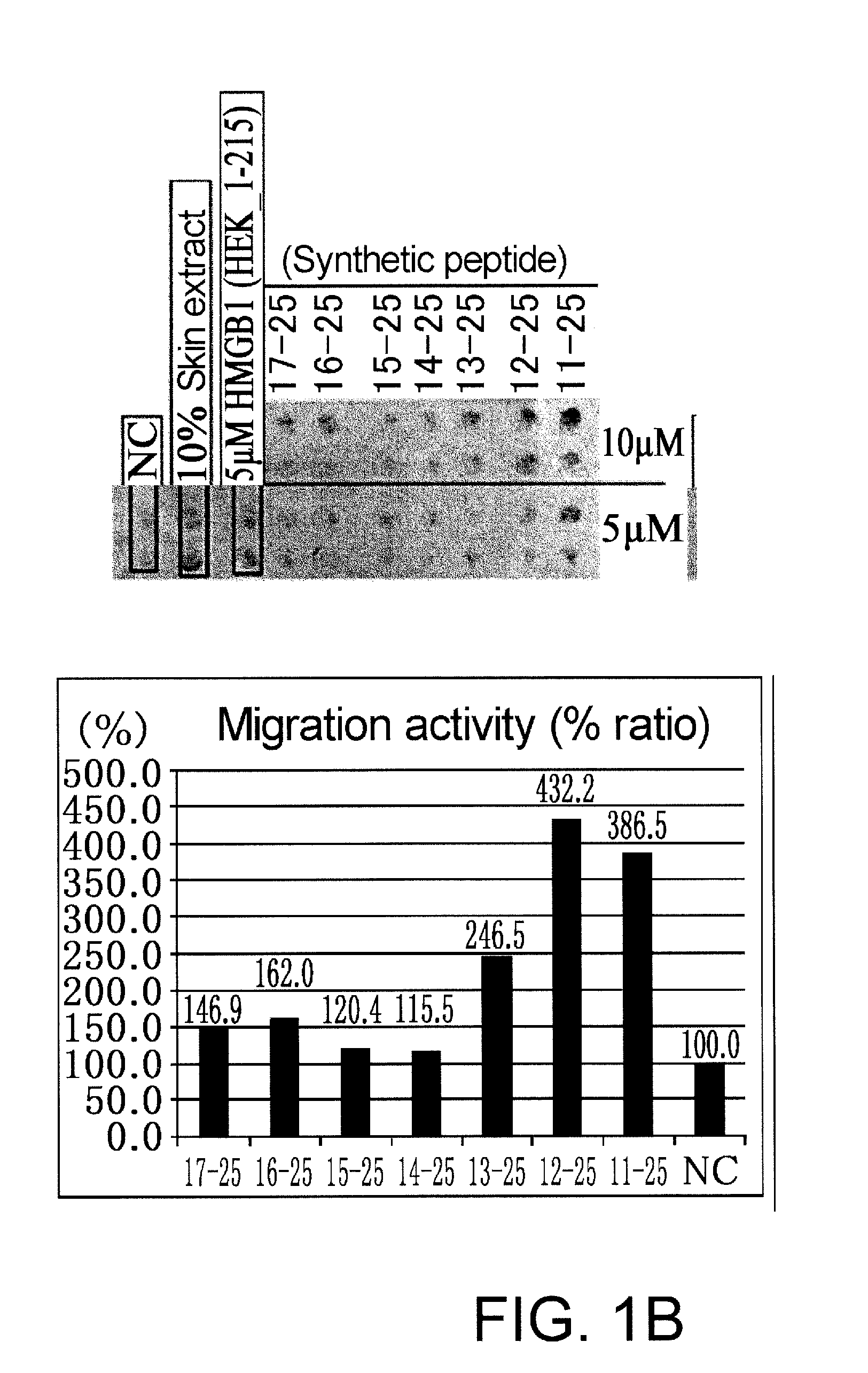Novel Method for Treating Spinal Cord Injury Using HMGB1 Fragment
a technology of hmgb1 and spinal cord injury, applied in the field of new therapeutic pharmaceutical compositions for spinal cord injury, can solve the problems of limited amount that can be collected from patients, difficult to obtain bone marrow mesenchymal stem cells necessary for treatment of a wide range of tissue damage, and difficult to maintain bone marrow mesenchymal stem cells, etc., to achieve the effect of therapeutic
- Summary
- Abstract
- Description
- Claims
- Application Information
AI Technical Summary
Benefits of technology
Problems solved by technology
Method used
Image
Examples
example 1
Assessment of Synthetic Peptides for Migration-Promoting Activity
(Methods)
[0066]The peptides listed below were custom synthesized using the solid phase method by Medical & Biological Laboratories (MBL). The peptides were synthesized based on the mouse HMGB1 sequence. Amino acid sequences from positions 1 to 169 of mouse HMGB1 and human HMGB1 are identical, i.e., shares 100% sequence homology.
A synthetic peptide consisting of the amino acid sequence from positions 1 to 10 of HMGB1 (1-10);
a synthetic peptide consisting of the amino acid sequence from positions 1 to 34 of HMGB1 (1-34);
a synthetic peptide consisting of the amino acid sequence from positions 11 to 20 of HMGB1 (11-20);
a synthetic peptide consisting of the amino acid sequence from positions 11 to 25 of HMGB1 (11-25);
a synthetic peptide consisting of the amino acid sequence from positions 11 to 30 of HMGB1 (11-30);
a synthetic peptide consisting of the amino acid sequence from positions 11 to 34 of HMGB1 (11-34);
a synthetic ...
example 2
Methods
[0071]Seven-week-old female C57BL6 / J mice were used as test animals. After the mice were anesthetized by isoflurane inhalation, skin incision was made along the dorsal midline, and the vertebral arch of the ninth thoracic vertebra was exposed and excised. Dura mater was exposed at the same site, and the spinal cord was held epidurally for three seconds using a microneedle holder to produce a traumatic injury of the spinal cord. After generation of injury of the spinal cord, the skin was sutured. Injury of the spinal cord was confirmed on the next day of operation by assessing paralysis of both hindlimbs, and mice that did not show paralysis were excluded from the assay. The assay reagent was prepared by diluting 100 μg of an HMGB1 fragment (amino acid sequence: amino acids of positions 11 to 44; synthesized peptide produced at MBL) in 200 μL of Dulbecco's PBS (D-PBS). 200 μL of D-PBS was used for the negative control. On the next day of operation, the first administration was...
example 3
Methods
[0074]Seven-week-old female C57BL6 / J mice were used as test animals. After the mice were anesthetized by isoflurane inhalation, skin incision was made along the dorsal midline, and the vertebral arch of the ninth thoracic vertebra was exposed and excised. Dura mater was exposed at the same site, and the spinal cord was held epidurally for three seconds using a microneedle holder to produce a traumatic injury of the spinal cord. After production of injury of the spinal cord, the skin was sutured. Injury of the spinal cord was confirmed on the next day of operation by assessing paralysis of both hindlimbs, and mice that did not show paralysis were excluded from the assay. An HMGB1 fragment (amino acid sequence: the amino acids of positions 11 to 44; synthetic peptide produced at MBL) was prepared by diluting 100 μg of the fragment in 200 μL of Dulbecco's PBS (D-PBS). The full-length HMGB1 protein was produced by expressing it in HEK293 as reported previously, and the purified H...
PUM
| Property | Measurement | Unit |
|---|---|---|
| structure | aaaaa | aaaaa |
| lengths | aaaaa | aaaaa |
| size | aaaaa | aaaaa |
Abstract
Description
Claims
Application Information
 Login to View More
Login to View More - R&D
- Intellectual Property
- Life Sciences
- Materials
- Tech Scout
- Unparalleled Data Quality
- Higher Quality Content
- 60% Fewer Hallucinations
Browse by: Latest US Patents, China's latest patents, Technical Efficacy Thesaurus, Application Domain, Technology Topic, Popular Technical Reports.
© 2025 PatSnap. All rights reserved.Legal|Privacy policy|Modern Slavery Act Transparency Statement|Sitemap|About US| Contact US: help@patsnap.com



